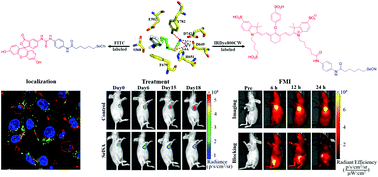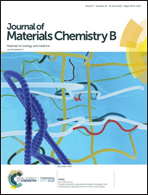A selenium-containing selective histone deacetylase 6 inhibitor for targeted in vivo breast tumor imaging and therapy†
Abstract
Early detection and effective treatment are essential for the management of breast cancer, especially for triple-negative breast cancer (TNBC). However, current imaging methods and treatment strategies are ineffective because of the lack of efficient biomarkers and molecular targets. Thus, identifying novel biomarkers and their corresponding ligands is critical for controlling breast cancer. Histone deacetylase 6 (HDAC6) has emerged as a valid target for cancer therapy owing to its selective tumor inhibition and fewer side effects compared to pan-HDAC- and HDAC1–3 isoform-selective inhibitors. Here, a HDAC6-selective inhibitor, SelSA, was developed by utilizing a selenocyanide moiety instead of the conventional hydroxamic acid core, which showed 112-fold and 128-fold selective binding affinity for HDAC6 relative to HDAC1 and HDAC8. In vitro studies demonstrated that FITC-SelSA was specifically uptaken by both ERα(+) MCF-7 and TNBC MDA-MB-231 cells, with primarily cytoplasmic localization. SelSA reactivated ERα expression and sensitized TNBC cell responses to the antagonist tamoxifen, and displayed potent antitumor effects against both MCF-7 and MDA-MB-231 cells in vitro and tumor xenografts in vivo with no obvious side effects. Moreover, in in vivo near-infrared fluorescence imaging to assess SelSA biodistribution, the IRDye800CW-SelSA probe exhibited specific tumor targeting ability with high tumor-to-normal tissue contrast. The in vivo tumor treatment study revealed that SelSA possessed improved treatment efficacy and fewer side effects in both ERα(+) and TNBC tumors, compared to pan-HDAC inhibitors. Overall, our study indicated that the HDAC6 inhibitor SelSA is a highly promising candidate for targeted breast cancer imaging and therapy with clinical translational potential.

- This article is part of the themed collection: 2019 Journal of Materials Chemistry B HOT Papers


 Please wait while we load your content...
Please wait while we load your content...